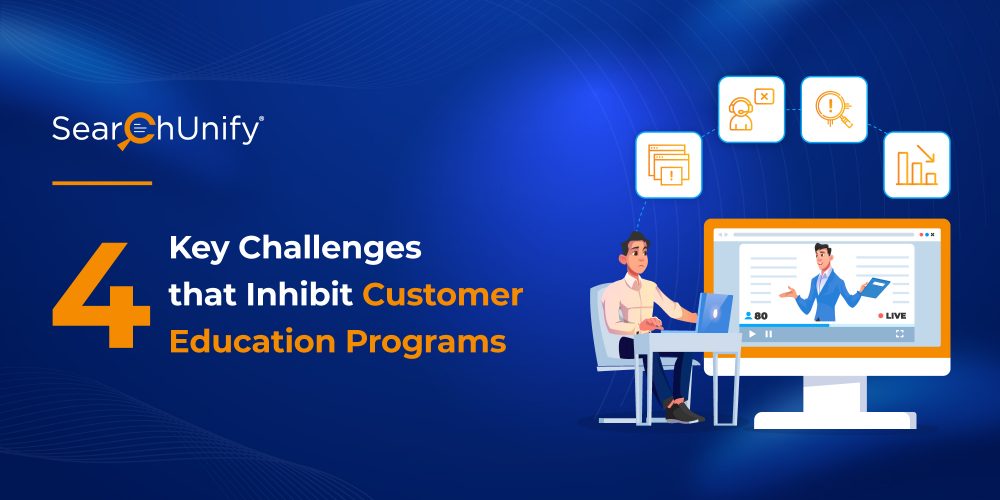
Companies today are building highly advanced products. While they boast of several innovative capabilities, the vast offerings often leave customers scratching their heads.
As a result, they fail to fully utilize the product and stay elusive from its true value. This disconnect unwittingly leads to customer churn—when customers feel they are not receiving the desired outcomes, they start looking for alternatives.
Imagine X sells picture editing software. Ron buys it to work on his professional photos by changing or removing the background. He starts to manually edit the background, totally unaware that a one-click background removal feature also exists. Frustrated, he jumps ship and runs to Y, X’s biggest competitor, which offers an in-depth product tour that equips him with the knowledge of various features and how they work.
That’s why an increased emphasis is being placed on customer training. It not only onboards your customers but also acts as a business driver. And customer education programs are the best way to go about it.
What are Customer Education Programs?
Customer education can be defined as the process of enhancing the customers’ knowledge about your offering and enabling them to quickly drive value. It typically commences before they buy your products or avail services and continues throughout their lifecycle. Let’s understand with an example:
Stage 1: Prospective customers can be engaged with educational content engineered around product features and how it helped other users achieve their desired outcomes.
Stage 2: New customers might need some assistance to understand the basics of using your product.
Stage 3: Finally, long-term customers would require education on optimizing their product usage and extracting more value.
An effective customer education strategy fuels your customers’ success. In fact, 90% of companies working on customer education have seen a positive return on their initiatives. What’s more, the State of Customer Education 2022 found that this year and beyond, nearly a third of surveyed customer education teams are focused on growing and enhancing the learning experience.
However, maturing these programs in pursuit of meaningful business returns is no walk in the park. It tags along a couple of challenges. Let’s find out what they are.
4 Roadblocks That Hamstring Learner’s Experience
Enterprises have a hard time tackling the following challenges which, if not properly dealt with, can derail the entire customer education program. These include:
1. Swiveling Between Multiple Platforms
Back in the day, product kits and brochures reigned supreme for helping customers better leverage their products. But not anymore! The digital revolution has pushed organizations to develop customary product education or training tools for their users.
However, there is some trouble in paradise. As training material propagates across sources, it gives birth to data silos that unearth problems like poor content findability. Hence, it becomes imperative to ensure the right learning content is accessible to users at the right time.
2. Ignoring the Voice of Customers
Many organizations are developing advanced products to ace new markets or gain a substantial share in existing ones. They do so by designing and developing products the customer wants.
However, if the training material or product tour does not incorporate the voice of customers and address the issues they face or the industry jargon, all the efforts and resources to create a best-in-class product can go down the drain.
Let’s say a health clinic implements a federated search that doesn’t integrate taxonomy. When an end-user runs a query with the search keyword “Covid-19 Vaccination,” hundreds of results are populated. The reason is—the health clinic has documented SARS-CoV-2 vaccination but disregarded the colloquial name Covid-19. As the federated search solution didn’t integrate taxonomy or leverage synonym mapping, it returns different results relating to vaccination without gauging the context of the query. As a result, the end users have to scroll through the entire list to find relevant answers, thus unwittingly marring their experience.
3. Catering Impersonal & Irrelevant Experiences
Gone are the dark ages of little to no personalization. Modern users demand hyper-personalized product experiences, and deservedly so. Businesses today front-load knowledge around functionalities in multiple ways like documentation, how-to videos, etc. But more often than not, this variety impedes the optimum utilization of the product and hampers CX. How, you may ask?
For instance, a beginner won’t be interested in the advanced version of your product or recent bug fixes. They would rather want to get the basics straight. So giving them unrelated technical documentation too early will be just shy of pointless.
4. Improper Mapping of Adoption Rate
Informal and formal learning patterns add different values to the learning curve of the users. However, organizations fail to track both, formal and informal, learning experiences to successfully map the adoption rate.
As a result, organizations are not sure whether the customers are past basic adoption or are already using the product in more advanced ways.
Here’s How You Can Knock Out the Learner’s Achilles Heel
The Thought Industries 2021 State of Customer Education Report found that despite making significant investments, 68% of customer learning leaders still consider their program underperforming relative to their learners’ needs. That’s a huge gap to overlook. With so much at stake, how can you level up your program and guarantee a stellar customer experience?
We got you covered!
SearchUnify is back with another high-impact webinar. This time, Samantha Valladao, Customer Education Program Manager at Thought Industries, and Vishal Sharma, CTO of SearchUnify, will discuss the key considerations for building a scalable customer education strategy. Additionally, they will also reveal how cognitive technology improves learning content searchability and tracking learner performance.
What’s not to love? Register today!
















